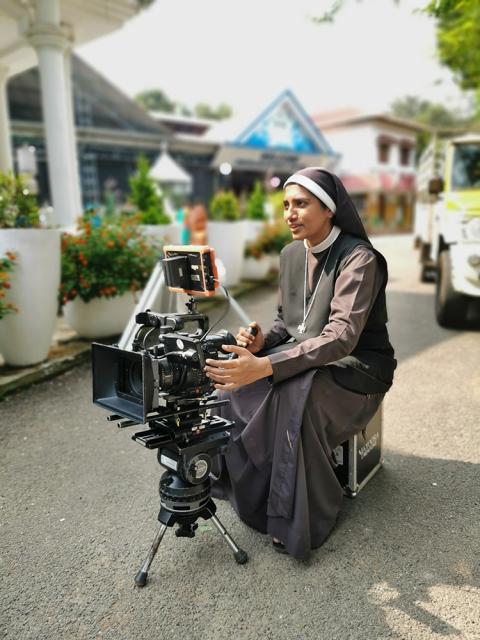
Sr. Lismy Parayil, a Congregation of Mother of Carmel sister known as the "camera nun of India" among media workers in the southwestern Indian state of Kerala (GSR photo/Ronnie Thomas)
Sr. Lismy Parayil, a member of the Congregation of Mother of Carmel, is the first Catholic nun to feature in the "India Book of Records" — the highest recognition in visual media in the country. Parayil was selected by a panel of chief editors of record books from India, Bangladesh, Indonesia, Malaysia, Nepal, Thailand, the United States and Vietnam. Media people in the southwestern Indian state of Kerala now call her the "camera nun."

Carmelite Sr. Lismy Parayil with her camera during one of her short film shoots (Courtesy of Sr. Lismy Parayil)
The 38-year-old cinematographer has so far recorded more than 1,500 videos — music albums, short films, documentaries, interviews and devotional songs. One of her outstanding videos was on "Thrissur Pooram" (a religious and cultural festival in Kerala's Thrissur town), a major Hindu cultural festival in India.
Parayil manages a YouTube channel for her congregation that has more than 1 million views. She has uploaded hundreds of her videos there.
Parayil spoke to Global Sisters Report on how she translates her talent into a new way of proclaiming Christ and how she balances her religious identity and mission in the church.
GSR: How do you like to be called the "Camera Nun of India?"
Parayil: I am a Carmelite nun, not a camera nun. Camera is a tool I use to assert my nunhood, my vocation and my mission. I look at the world through my camera lens and tell the stories of Jesus, Christian values and messages. My congregation has recognized the new apostolate's potential to reach out to a larger population; especially young people.
Advertisement
What is your latest work?
My latest short film is "Pidakozhi" (hen) which was inspired by a true story of a girl, Sandra [name changed] I had counseled at a rehabilitation center. The girl was on the verge of committing suicide after being gang-raped. She was rescued by a nun and later married to a young man named Joseph. I released the film on May 1, the feast of St. Joseph the Worker, an icon of purity and sanctity. The film was well received.
How did you start using the camera in the convent?
When I joined the convent, I never knew I had this talent. My congregation identified my hidden talents and promoted me. It was during my formation period that I got an opportunity to use the convent camera to shoot a stage function. Then my superior asked me to shoot a dance sequence for a Christian devotional song for our community feast. I shot my first work with the help of other sisters. That came out well. After everyone liked it, my superiors gave me more opportunities to make music albums about our congregation. I started shooting and uploading videos in 2013.

Carmelite Sr. Lismy Parayil, who was listed in the India Book of Records as the first cinematographer nun in India, shows her award and citation. (Courtesy of Sr. Lismy Parayil)
You are the first Catholic nun to feature in the "India Book of Records." How do you look at the award?
I am happy about the award and to be listed in the India Book of Records. This is for the glory of God. There could be more talented camera women in society. But they chose me, perhaps, because I am a nun. Nuns rarely get into this field and, even if they do, few get their superiors' support. In my case, it was my congregation that recognized my talent and encouraged me. So, I dedicate this award to my congregation. Today, my videos have more than 1 million viewers.
What is your most popular work?
We are meeting at the time of "Thrissur Pooram," which is a celebration of communal harmony and cultural extravaganza, although it is a Hindu festival. Last year, I produced an album on the festival that drew much attention. It was a rare view for people to see a Catholic nun shooting the "Pooram" from every angle — the drums, the elephant parade, procession, people and fireworks. I have presented it as a celebration of unity with messages from Hindu, Christian and Muslim leaders.

A massive crowd at "Thrissur Pooram," a cultural festival associated with a Hindu temple at Thrissur in the southwestern Indian state of Kerala (GSR photo/Ronnie Thomas)
Do others help you?
Most often, I not only handle the camera, but write the script, dialogues, screenplay, edit and direct. When I work for other congregations or productions, I follow their script, but do the direction and editing. For short films, I do everything from conceiving the story idea to the final product. I learned the art of making movies from the YouTube instructions and worked long hours at night to edit and present them. But today, our province has a full-pledged studio that I use.
How do you get story ideas?
I draw inspiration from real-life situations. I produced a short film about a 93-year-old mason woman I met on the roadside. She does all the work, including building houses, digging wells, or manual jobs in fields. On another occasion, I met a small boy playing country violin at a railway station and he told me that he took to street performance after his father died of COVID-19.

Carmelite Sr. Lismy Parayil and her team record the performance of young percussion artists in front of a Hindu temple in Thrissur, the cultural capital of the southwestern Indian state of Kerala. (GSR photo/Ronnie Thomas)
How do you get time for all this? Don't you have other responsibilities as a nun?
My superiors have allowed me to work full-time in this field for the past few years. They have also asked me to assist in vocation promotion. My superiors are convinced about the new ministry ability to reach a wider audience. We have to change according to the time. People now have no time for traditional ways of preaching. But when given through social media and audio-visual platforms, those messages go very far.
Coming to vocations, many congregations in India suffer from lack of vocations. Is it true for your congregation?
We have not only enough vocations, but very talented girls now join us. We have sisters who have excelled in art, music and dance. They use their talents to preach the Gospel. We have several dancers, actors, speakers, writers and singers. Perhaps, they may have been inspired by my camera mission.

Carmelite Sr. Lismy Parayil with her camera (Courtesy of Sr. Lismy Parayil)
How do you promote talents among other nuns or other congregations?
One of my missions is to encourage more people to take up new forms of ministries using modern platforms. I have made documentaries for several congregations to get their members involved in similar projects. I have trained several nuns and instilled confidence in them. There was a time when mobile phones and the internet were prohibited for nuns. But time has changed now. The challenge now is to train nuns on how to use such devices for the mission effectively. I am happy that a few other nuns have proved their talents as cinematographers. So, I am not alone.
Do you have a dream project?
I am interested in making a full-length feature film on Christian values. But it requires much coordination, networking and money. The congregation has supported all my projects so far. I will not take up anything until my superiors are convinced about it. This year, I have been transferred to an interior convent. I may get more time there to think about how I can use my camera to tell more stories.
Why did you become a nun?
I grew up in a family with so many nuns and priests in many congregations. So, from my childhood, I wanted to become a nun, but was not sure about where to join. My mother advised me to join a congregation that venerates Mother Mary. After 10th grade, I joined a summer camp to discern my vocation and there I came in touch with my congregation. I came to know later that I have two aunts in the same congregation.







